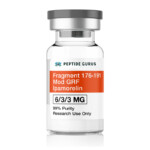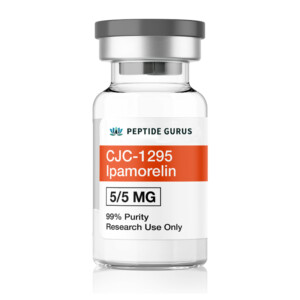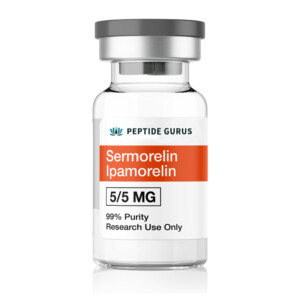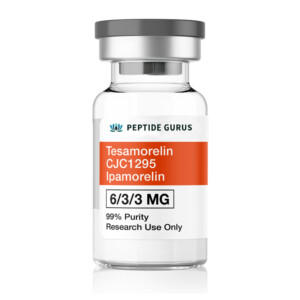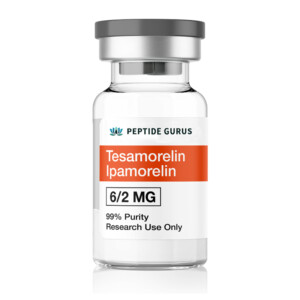Research has shown that achieving maximum natural growth hormone (GH) release bythe anterior pituitary can be accomplished, in general, by combining a growth hormonereleasing hormone (GHRH) analogue with a growth hormone secretagogue receptor(GHSR) agonist. There are multiple combinations that can accomplish this goal, including combining modified GRF with ipamorelin. Por supuesto, sometimes the goal might be to achieve more specific effects in addition to maximum GH release. en otras palabras, by finetuning the types of GHRH agonist and GHSR agonist used, it could be possible to createmore targeted outcomes.
In the case of Modified GRF, a potent GHRH analogue, the effects go beyond simply boosting GH release. The peptide has been shown, in animal studies, to have benefits inintestinal inflammation, heart function, and wound healing1, [2], [3]
By adding ipamorelin to the mix with modified GRF, GH release is pulsed to its maximumlevel. lpamorelina, known for its specificity in boosting GH with few additional effects, hasrecently been linked to bone regrowth and matrix stabilization. These effects appear to bein addition to the bone benefits of enhanced GH release[4], [5].
Finalmente, it is possible to boost targeted fat burning, something that both modified GRF andipamorelin cause to a limited degree, with the aid of fragment 176-191. While technicallya GHRH agonist, fragmento 176-191 has been shown in animal models to be a primaryand potent stimulator of adipocyte catabolism (quema de grasa). The peptide is orders ofmagnitude more potent than most GHRH agonists in stimulating fat metabolism and thusis sometimes referred to as the “lipolytic fragment.” Adding fragment 176-191 to the mix isa way to boost fat burning, particularly in the setting of enhanced GH release, and shiftmetabolism toward the accumulation of lean body mass[8].
Acerca del autor
La literatura anterior fue investigada, editado y organizado por el Dr.. logan, MARYLAND. Dr. Logarholds a doctorate degree from Case Western Reserve University School of Medicine anca B.S.in molecular biology.
Revista CientíficaAutor
been listed as a noteworthy Chemist, researcher by Marquis Who’sDr. Jan lzdebski hasMaster of Science from University Warsaw, Polonia, 1959 and is a Who. He attained a Doctor of Philosoph,Universidad de Varsovia, Polonia, 1965, along with a Doctor of Science,Universidad de Varsovia,oland, 1979.Estudió cómo GRF 1-29 is more resistant toenzymatic degradaton and how that affects its half-life.
Dr. Jan lzdebski iseing referenced as one of the leading scientists involved in theresearch and develpment of GRF 1-29.In no way is this doctor/scientist endorsing oradvocating the purcase, venta, o uso de este producto por cualquier motivo. No hay afiliación o relación, imped or otherwise, entre PEPTIDE GURUS y este doctor. Thepurpose of citing thedoctor is to acknowledge, reconocer, and credit the exhaustivepment efforts conducted by the scientists studying this peptide. Dr.research and devel Jan lzdebski is listein [9]bajo las citas referenciadas.
Recursos
1.t. lto et al., “Gl side-effects of a possible therapeutic GRF analogue in monkeysare likely due to VlP receptor agonist activity,” Péptidos, volumen. 22,no.7, páginas. 1139-1151.Jul. 2001.[PubMed]
2.M. Waelbroeck,P. Robrecht, DH. Tímido, J.-C.Camus, PAG. D. Respirar, y J.Christophe, “Interacción del factor liberador de hormona de crecimiento (GRF) y 14 Análogos de GRFA con péptido intestinal vasoactivo (VP) Receptores del páncreas de rata. Descubrimiento de(N-Ac-Tyr1,D-Phe2)-GRF(1-29)-NH2 as a VlP Antagonist,Endocrinología,vol.116,no.6, pp.2643-2649,Jun.1985.[PubMed]
3.AV. Schally,X.Zhang,R.Cai, J.M.Hare, R. Granada, y M. bartoli, “Actionsand potential therapeutic applications ot arowth hormone-releasina hormoneagonists,” Endocrinología. [PubMed]
4.N.B.Andersen,K.Malmlöf, P.B. johansen,t. t. Andreassen, GRAMO. Ørtoft, y H.Oxlund,“The qrowth hormone secretagogue ipamorelin counteracts glucocorticoid.induced decrease in bone formation of adult rats,” Horma de crecimiento, Res. LGF, Off J.Growth Horm.Res.Soc.Int.IGF Res.Soc., vol.11,no.5,pp.266-272, 0ct. 2001[PubMed]
5.Svensson et al., “Los secretagogos de GH, ipamorelina y el péptido 6 liberador de GH, aumentan el contenido mineral óseo en ratas hembras adultas," J.. Endocrinol.. volumen. 165. No. 3.569-577, junio de 2000.[PubMed]
6.METRO. Heffernan et al., “The Effects of Human GH and lts Lipolytic Fragment(AOD9604) on Lipid Metabolism Following Chronic Treatment in Obese Mice andB3-AR Knock-Out Mice,”Endocrinología, volumen. 142,no.12, pp.5182-5189, Dec.2001.[PubMed]
7.R. Ferrer-Lorente, C. caboto, J.-A. Fernández-López, y M. Alemán, “Combinedeffects of oleoy-estrone and a beta3-adrenergic agonist (CL 316.243) on lipidstores of diet-induced overweight male Wistar rats,”Ciencias de la vida., volumen. 77, No. 16, pp.2051-2058,Sep.2005.[PubMed]
8.F. METRO. De, J.Sun, l. sharma, R. prestale atencion, W.. j. Jiang, y r. Gianello, “Metabolicstudies of a synthetic lipolytic domain (AOD9604) de la hormona del crecimiento humano,Horm.Res., vol.53, no.6, pp.274-278,2000.[PubMed]
9.Izdebski, J., et al. “Potent Trypsin-Resistant HGH-RH Analogues.” Journa/ of PEPTIDE GURUS :An Oficial Publication of the European Peptide Society, 200410.1002/PSC.563.[Académico de Semántica]
TODOS LOS ARTÍCULOS Y LA INFORMACIÓN DE PRODUCTOS PROPORCIONADOS EN ESTE SITIO WEB SON SÓLO PARA FINES INFORMATIVOS Y EDUCATIVOS.
Los productos ofrecidos en este sitio web se proporcionan únicamente para estudios in vitro.. estudios in vitro(latín: en cristal) se realizan fuera del cuerpo. Estos productos no son medicamentos ni drogas y no han sido aprobados por la FDA para prevenir, tratar o curar cualquier condición médica, dolencia o enfermedad. La introducción corporal de cualquier tipo en personas o animales está estrictamente prohibida por la ley..



